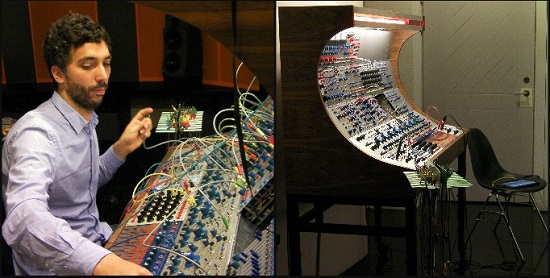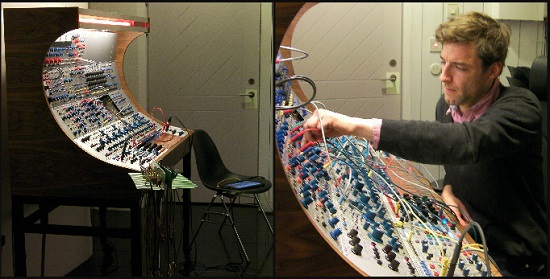I can’t comment on the current state of either Jonathan Fitoussi or Clemens Hourrière’s facial hair, and the only photo I have of them working in collaboration is a close, well-maintained beard on the former and the merest hint of stubble on the latter. I mention this because it’s been noted in some quarters that we may be facing a surfeit of representations of ‘dudes’ with full beards playing modular synths and, like all of you I’m sure, I do my best not to go about blindly reproducing cultural hegemonies. Still, degrees of hirsuteness aside, what follows is very definitely a tale of man and modular synthesiser; there’s nowhere to hide on those counts – a vintage synth, the Buchla 200, is the exclusive focus of Fitoussi and Hourrière’s arresting Five Steps album. The title itself is linked to the machine the Buchla company marketed in the 70s as the ‘Electric Music Box’ (its creator, Don Buchla, built it as the replacement for his ‘Buchla 100 Series Modular Electronic Music System’, as heard on Morton Subotnick’s Silver Apples Of The Moon), and of which there are now apparently only ten in the world. As Fitoussi explains, “The instrument has a five-step sequencer, or five notes, which is pretty basic but which gives it all of its charm. But the title also links to the five days we spent in the studio in Stockholm, with every day a new stage in the learning experience… step by step.”
The recording was the result of an invitation by the Elektronmusikstudion (EMS) in Sweden, a studio established in the 60s and, like our Radiophonic Workshop, linked initially to Swedish national radio. Both fans of vintage hardware, Hourrière and Fitoussi were never likely to refuse. In fact, it seems as though they might initially have invited themselves, or at least dropped some heavy hints. According to Hourrière, “Jonathan had the idea for this residence. We were really keen to get up close to the Buchla.”
The pair already had history – Fitoussi says they first met at a school for sound engineers. “We’ve been making music together for 15 years,” working on everything from garage rock to more electronic projects like this.” One of those projects is the “psych garage rock” group One Switch To Collision, signed to Turzi’s Pan European label in 2007. “This project now as a duo is very different but I think the approach and the methodology are pretty similar in the end, instinctive and intuitive. Sharing this experience at EMS seemed like a logical progression.”
But could the Buchla live up to their expectations? It certainly did for Fitoussi. “We’d never laid hands on one. It was really exciting going to spend a week working with a rare synthesiser, but in the beginning we had no idea we’d be coming back home with an album. The palette of sounds is really magical and allows you to create really unique structures and textures.”
Hourrière is even more emphatic. “I really fell in love with it. When I came back home afterwards I had just one idea in my head, which was to try to make one myself. We mastered the machine little by little. The system in Stockholm was really complete – well the keyboard didn’t work and the sequencer was a bit dodgy, but we managed and the limitations were motivating.”

On the issue of (retro) fetishism (it’s worth noting the album sleevenotes, by Jesse Hultburg, already anticipate and address that charge), Hourrière says quite straightforwardly that “old synthesisers inspire me and make me think. The fact of having all the controls in front of you and not in menus inspires me. And you have to admit they are pleasing to look at.” For Fitoussi, “this synth is very rare, so of course, but I think I know people who have the same feelings about rare electric guitars.”
The other question that presents itself more frequently with synths than guitars, and which becomes more pertinent when dealing with an unfamiliar system, is that of who (or what) is calling the shots. Did the Buchla suggest compositional approaches?
Hourrière is quite open on the point: “I think the machine definitely guided us a bit, through its textures and its sounds, but we didn’t leave things up to chance, we really tried to find the types of sounds we had in mind… but obviously, the limitations of the machine – no keyboard, the five-step sequencer – obviously influenced the compositions!” Fitoussi credits his musical partner’s input as much as anything: “It’s an extremely different approach from other synthesisers, it was a little unsettling at first. But Clemens was really equal to the task, he had really studied the system before leaving Paris and he quickly grasped its idiosyncrasies. From the beginning we wanted to make something musical and I think we achieved that. We also wanted to create some very percussive sounds that are particular to the Buchla and which can’t be reproduced by other synths.”
The pair recorded Five Steps almost entirely live, using only the Buchla and the two pedals each they allowed themselves. “We left Paris with just our hand-luggage,” Fitoussi recalls. “The synth is very big, you can easily have two people working on it at the same time, and when we were ready we recorded our parts simultaneously on separate tracks.”
The result is fantastically vivid, tactile even; textures are pin-sharp or tacky. Hourrière eulogises the “natural, organic” sound, and the percussive moments are noticeably ‘woody’. But for all the richness, nothing sounds entirely natural. I’ve started to see each track as a sort of synthesised polymer, bringing to mind multi-coloured molecular models. There’s also an appealing rigidity, frigidity even, which is also linked to that percussive approach – the synth doesn’t ‘swing’.
Rather than molecules, though, they had a film of sorts in mind according to Fitoussi. “After two days in the studio, we already had three or four tracks recorded, and Clemens was saying that it sounded very soundtracky, and he was right, so we carried on in that direction.”
In that case, I suggest – especially given titles like ‘Solstice Winter’ and ‘Moonish Landscapes’ and ‘Ice Stalactite’ – the film would be a documentary about a cold, remote landscape. The inspiration, however, was definitely local.
“In the evenings as we were leaving the studio, night had nearly fallen but the sky and the light were magnificent and the atmosphere of Stockholm was peaceful, calming. Those images influenced our compositions, for sure.”
Rockfort also recommends:
Bon Voyage Organisation – Xinge EP
If the legacy of Daft Punk’s bid to ‘Give Life Back To Music’ through the medium of disco is to come in the form of releases like this, then I’m all for it. The reality though is that it’s hard to imagine many releases that will be as full-phat creamy and rich as Xinge, which was recorded with the assistance of Daft Punk engineer Florian Lagatta. Adrien Durand, who has previously had releases on Jamal Moss’s Mathematics Recordings, has described the EP as being shaped by “ethno-futurism”, focused on the effect of Chinese involvement in Africa as a vision of our collective future. "This exchange between China and Africa is to me the most Sci-Fi-ish event happening these days, much more interesting than anything related to new technologies… Mandarin is the next universal language Durand taps into old-fashioned musicianly virtues – BVO is a real band, Durand working with a drummer, keyboard player, guitarist, flautist, and Chinese singer LiLijua. It’s a different take on disco as a cultural crossroads, a place where real-world tensions are temporarily resolved, sublimated. Not just a marriage, more like a mirage of Chinese-sounding melodies, airport-loungey announcements, synthesiser goo and dancefloor propulsion, finished with a near-hallucinatory advertorial gloss.
La Nuit – Desert Television
A rapid return to this column for Félicia Atkinson in a lush collaboration with American Peter Broderick. From the off, the Fender Rhodes sound Atkinson is so partial to makes its reappearance, as well as her spoken-word lyrics and poetry, but here the tension of A Readymade Ceremony largely gives way to the languor and drift of parched nights, just veering off for the highway drama and concussed imagery of ‘Road Snakes’. It’s as entirely enveloping and beguiling as you hope a project called La Nuit would be.


